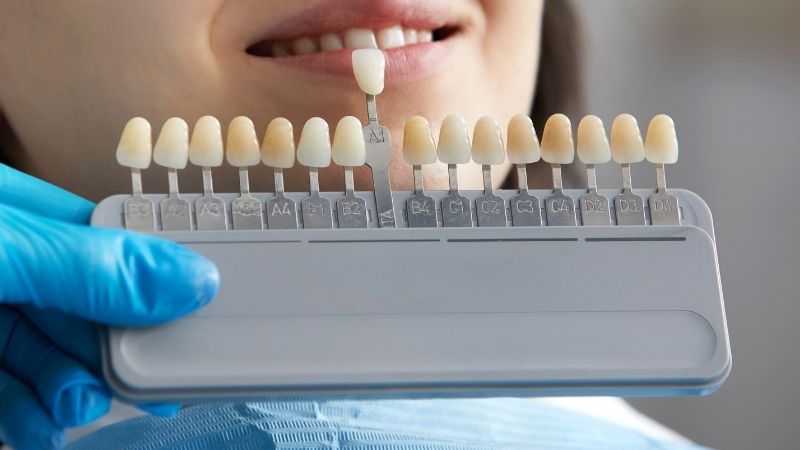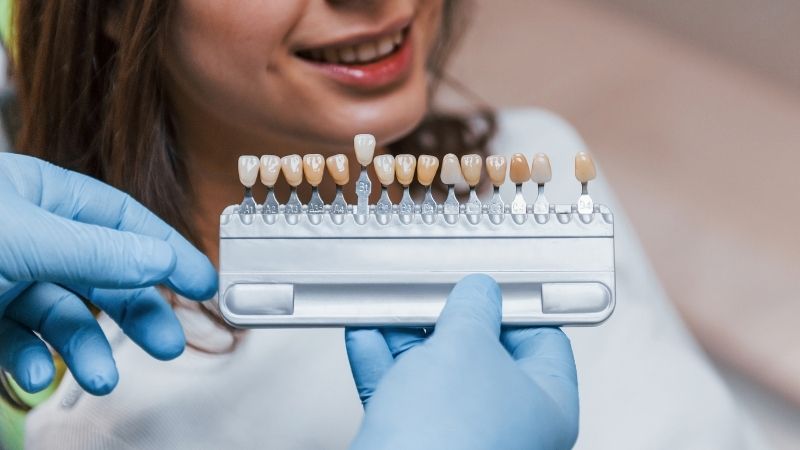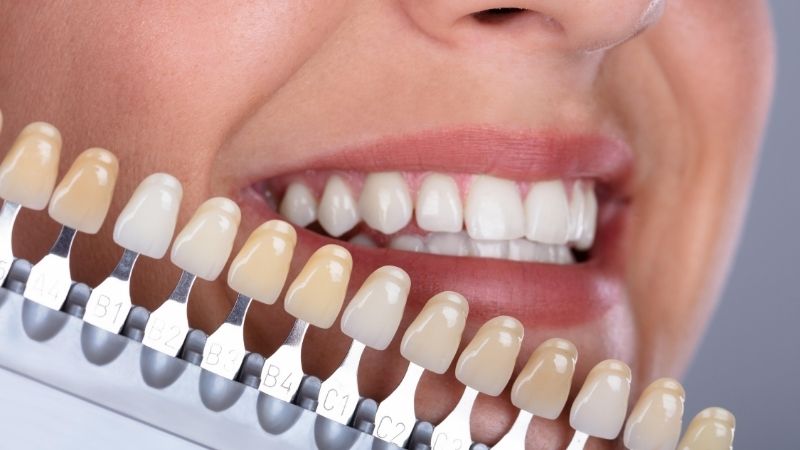Tooth colour plays a big role in the final appearance of your smile, especially when planning treatments such as Emax crowns, or veneers. A1 Tooth shade is one of the lightest natural tooth shades, but it is not excessively white. Very similar to natural tooth colour as it contains reddish-brown undertones. It provides an appearance as if you have received teeth whitening treatment. We have prepared a guide for you to better understand A1 tooth shade.

What is A1 tooth shade?
A1 is one of the natural tooth shades used in dentistry. Dentists use shade guides to select the tooth shade for treatments such as veneers and crowns. The most commonly used is VITA classic shade guide. Patients can choose the right shade for their teeth with this shade guide.
VITA dental guide has shades categorised from A to D. The shade A1 is part of the A group, which includes warm-toned tooth colours. Among the group A shades, A1 is the brightest and lightest. It has a natural and healthy appearance.
Patients want A1 when they want a whiter smile but do not want an overly ‘Hollywood’ look.
A1 tooth shade is easier to maintain than whiter, bleached shades because it does not show staining quickly. However, if the patient's natural tooth colour is darker, A1 looks bright. In such cases, we recommend teeth whitening first so that the new restorations are better matched. If a full restoration is to be made, the tooth shade colour is determined by considering the patient's skin tone and lifestyle.
Understanding natural tooth shades
Natural tooth colour appears whiter or more yellow depending on the thickness of the enamel. It also varies depending on age, genetics and lifestyle. Some people have naturally brighter teeth, while others may have teeth that appear more yellow or grey.
Natural tooth colours also lose their whiteness over time. Staining from coffee, tea, cigarettes, and acidic drinks can make teeth darker or more yellow.
In short, everyone's natural tooth tone is different. For this reason, when choosing a tooth shade, it is necessary to choose by considering the colour of the existing teeth.
What are Hollywood white teeth shades?
Hollywood white is a term used for very bright, white teeth. These shades are whiter and brighter than natural tooth colours. They are preferred by people who want to have sparkling teeth like the teeth of Hollywood stars.
Hollywood white shades are labelled as BL1, BL2, BL3 or BL4. BL1 is the brightest and whitest, while BL4 is less white. In any case, these shades are still brighter than natural shades. These shades are mostly used in smile makeover treatments in Fethiye.
Hollywood white is more difficult to maintain than natural tooth shades. Stains or discolouration are more easily visible on teeth with bleaching shades. A good dental care routine is required to keep Hollywood white teeth looking bright for a long time.
Is A1 tooth shade good?
A1 is one of the brightest shades in Vita's natural tooth colour range. Although it is one of the whitest, it has a healthy and natural appearance. It has a yellowish undertone, which contributes to its natural appearance. In short, it is perfect for people who want to have a natural smile but have white teeth. It is used quite frequently in partial restoration treatments. Because it is can adapt well to natural teeth. However, if the natural teeth are darker, A1 may look too white and artificial. In this case, harmony must be achieved between natural teeth and restorations. As a solution, bleaching is applied to the existing teeth.
Today, Fethiye dental veneers and crowns are resistant to staining. A1 is also easier to maintain than bleached shades. It hides discolouration better.
How do different tooth shades compare?
Tooth colours differ in brightness, hue and undertone. Dentists use shade guides to clearly explain these differences. Tooth colours are commonly divided into groups A, B, C and D. Each group is divided into subtones. Numbers such as 1, 2 or 3 refer to the level of brightness. 1 is the lightest and brightest undertone and higher numbers are darker. For example, as you go from A1 to A3 tooth shade, darker shades are seen.
Different shades create different smiles. Lighter shades such as A1 or B1 look younger and more dynamic. Darker shades such as A3 or C3 are preferred by older people or people who do not receive teeth whitening treatment.
You can make an easier and clearer choice by comparing tooth shades.
1. A1 vs B1 tooth color
A1 and B1 are two of the whitest and popular natural tooth shades.
A1 tooth shade belongs to group A, which has reddish brown undertones. For this reason, it has a warmer and yellow undertone. It has a very natural look. Tooth shade B1 has reddish yellow undertones. B1 is generally considered the brightest shade in the natural range. It appears slightly whiter and brighter than A1.
Dentists recommend B1 for people who want a whiter smile but remain within the natural shade range. A1 is ideal for those who prefer a more natural look.

2. A1 vs C1 tooth shade
C1 belongs to group C, which has grey undertones. C1 has a cooler tone compared to tooth shade A1. It is not as bright as A1 but is still considered a light shade within its group. The dentist recommends C1 for patients whose natural tooth colour already has cooler or greyer tones. A1 is recommended for those who prefer a softer, warmer appearance.

3. A1 vs A2 teeth color
A2 tooth shade is darker and more yellowish than A1. It is preferred for people with thinner enamel or for those whose teeth naturally have a warmer shade. A2 gives a softer, less shiny appearance compared to A1. A1 is recommended for younger patients or those who want a whiter smile. A2 is generally recommended for patients who prefer a more natural and mature look.
How to choose the best tooth shade?
When choosing the right tooth shade, the patient's skin tone and the colour of their natural teeth are taken into consideration. Skin tone determines how white the teeth will appear. Shades that are too white will look artificial on darker skin tones as they will look too shimmery. Warmer shades such as A1 or A2 are suitable for people with warm skin tones. Cooler shades such as B1 or C1 suit people with cool skin tones.
When choosing the right tooth tone, the age factor should also be considered. Whiter and brighter tooth shades are more suitable for younger patients, while softer shades are suitable for older patients.
Existing teeth are another factor. If only one or two teeth are being restored, the new teeth should match the natural teeth. In full mouth treatments, patients can choose a brighter shade if they wish.
Lifestyle is also important. While people who are in the public eye prefer whiter tones, people whose social life is more limited or smokers may prefer darker tones.
With the guidance of dentists, tooth shade guides and digital scanner devices, the patient can choose the tooth shade accurately and easily.
Conclusion
Tooth shade A1 has warm undertones like most natural teeth. That's why A1 is one of the most popular choices for patients who want natural-looking but white teeth. It is ideal for crowns, veneers and implants, especially for those looking for a youthful yet realistic result. Compared to bleached shades, A1 is easier to maintain. Dentists recommend A1 for veneers when patients want a very natural look.
